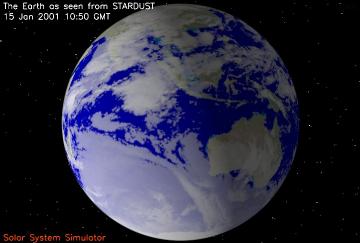| |
 
|
 |

STARDUST Visible During Earth Flyby?
There is a small possibility that STARDUST may be visible from Earth just prior to its closest approach to Earth as it is passing over the South Pacific and Australia. However, the spacecraft will be faint (around 11 magnitude or fainter), and the use of sophisticated telescopes with CCD detectors will be required. The spacecraft will not be visible using binoculars. A customizable ephemeris for Stardust during the Earth flyby is available as an aid in tracking the spacecraft.
Stardust spacecraft may be visible January 14-15 The Stardust spacecraft is returning to the Earth for a swingby about two years after its launch, similar to NEAR's Earth swingby of 1998 Jan. 23. The best time to watch will be when the spacecraft is at least 20 deg. above the horizon closest to the time of its closest approach at about 11:15 U.T. January 15 U.T., and before that closest approach, since it will be approaching the Earth with a small phase angle (like NEAR) but departing with a much less favorable approx. 90 deg. phase angle. For the Americas, the best time will be around midnight Sunday night, Jan. 14-15. The best areas for observation will probably be the Orient, and Australasia, the western Pacific region. You can calculate an ephemeris for your location using JPL's ephemeris generator at http://ssd.jpl.nasa.gov/horizons.html Modify the "current settings" to select Stardust (in the "major body" box) and select your city, or one near you, from their very extensive city database (Greenbelt, MD, is in it). Then set the time interval you want, and check the quantities you want in the ephemeris. William Blume (JPL) gives some predictions of the observability , but based on the NEAR flyby experience, I think it will be a little better, with Stardust probably being 11th mag. or brighter at the best times in North America. The spacecraft attitude is being controlled only in a "10 deg. deadband", so there will be no solar panel sunglint pointings like we did with NEAR. But you may be lucky and see a brief direct reflection of sunlight from the solar panels, which I think could be as bright as 4th to 6th mag. David Dunham, IOTA
Stardust Trajectory Jon Giogini (jdg@tycho.jpl.nasa.gov) Latest Stardust post-maneuver, pre-Earth fly-by (Jan 15 11:15 UTC) trajectory from the navigation team is accessible at:
telnet://ssd.jpl.nasa.gov:6775
(topocentric observer tables, elements, vectors. Type "stardust",
then follow prompts. ? or ?! explains prompt.)
http://ssd.jpl.nasa.gov/horizons.html
(observer tables only)
-- Jon Giorgini
J2000 Ecliptic heliocentric elements:
2451923.500000000 = A.D. 2001-Jan-14 00:00:00.0000 (TDB)
EC= 3.971868237175653E-01 QR= 9.562312821778280E-01
IN= 9.226679356159012E-03
OM= 2.715711750872453E+02 W = 2.293921980534217E+02
Tp= 2.451945915103786E+06
N = 4.933257195984641E-01 MA= 3.489420527949337E+02
TA=-2.732758968489939E+01
A = 1.586281321975960E+00 AD= 2.216331361774092E+00
PR= 7.297409920022358E+02
2451924.500000000 = A.D. 2001-Jan-15 00:00:00.0000 (TDB)
EC= 4.063483285001958E-01 QR= 9.556977718002366E-01
IN= 5.265180039460008E-03
OM= 2.514271634095720E+02 W = 2.495583077434385E+02
Tp= 2.451945852240112E+06
N = 4.825260407667660E-01 MA= 3.496969881171485E+02
TA=-2.617726537882492E+01
A = 1.609862850020715E+00 AD= 2.264027928241194E+00
PR= 7.460737236646049E+02
2451925.500000000 = A.D. 2001-Jan-16 00:00:00.0000 (TDB)
EC= 4.836314085399401E-01 QR= 9.831576808621124E-01
IN= 3.696307911459161E+00
OM= 1.153824850883206E+02 W = 3.571380138530885E+02
Tp= 2.451922649513395E+06
N = 3.751535291635117E-01 MA= 1.069370109702610E+00
TA= 3.508926751684556E+00
A = 1.903984280070525E+00 AD= 2.824810879278937E+00
PR= 9.596071261883104E+02
Symbol meaning [1 AU=149597870.691 km, 1 day=86400.0 s]:
JDTDB=Epoch Julian Date, Barycentric Dynamical Time
EC=Eccentricity,e
QR=Periapsis distance,q(AU)
IN=Inclination w.r.t xy-plane,i(degrees)
OM=Longitude of Ascending Node,OMEGA,(degrees)
W=Argument of Perifocus,w(degrees)
Tp=Time of periapsis (Julian day number)
N=Mean motion,n(degrees/day)
MA=Mean anomaly,M(degrees)
TA=True anomaly,nu(degrees)
A=Semi-major axis,a(AU)
AD=Apoapsis distance(AU)
PR=Orbital period (day)
Last Updated: November 26, 2003
|
|
|
|
